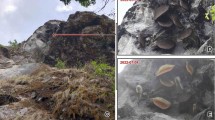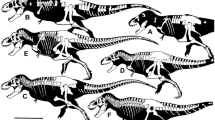Abstract
The caste developmental system of the Neotropical termite Constrictotermes cyphergaster was investigated in 12 natural colonies from the semi-arid Caatinga region of northeastern Brazil. Twelve measurements were taken of different body parts of the larvae, workers, presoldiers, soldiers, nymphs, and alates for morphometric analyses, and principal component analyses (PCA) were performed based on these parameters. The nymphal line comprised one larval instar, followed by five nymphal instars, and alates, in agreement with the developmental pattern described for Termitidae species. The apterous line included two larval instars, followed by workers, presoldiers, and soldiers. Both workers and soldiers were found to be monomorphic and composed only of male specimens, with only one instar phase each. C. cyphergaster, like most of the Nasutitermitinae, has only male soldiers. The presence of male workers, with only one instar, suggests a simplified system of differentiation in the apterous line of C. cyphergaster. These patterns, which had not previously been described for ‘full nasute’ Nasutitermitinae, are similar to the differentiation patterns of the ‘mandibulate nasute’ Cornitermes walkeri.





Similar content being viewed by others
References
Barsotti R.C. and Costa-Leonardo A.M. 2005. The caste system of Coptotermes gestroi (Isoptera: Rhinotermitidae). Sociobiology 46: 87–103
Bignell D.E. and Eggleton P. 2000. Termites in ecosystems. In: Termites: Evolution, Sociality, Symbioses, Ecology (Abe T., Bignell D.E. and Higashi M., Eds), Kluwer Academic Publishers, Dordrecht. pp 363–387
Clarke P.A. 1993. Alate production in colonies of Nasutitermes nigriceps and Nasutitermes costalis (Isoptera: Termitidae) in Jamaica and Trinidad. Sociobiology 23: 167–174
Clément G. 1953. Sur la différenciation d’ovocytes dans les testicules des “neutres” d’Anacanthotermes ochraceus. C.R. Acad. Sci. Paris 236: 1095–1096
Constantino R. 1995. Revision of the Neotropical termite genus Syntermes Holmgren (Isoptera: Termitidae). Univ. Kans. Sci. Bull. 55: 455–518
Constantino R. 1998. Catalog of the living termites of the new world (Insecta: Isoptera). Arq. Zool. 35: 135–231
Constantino R. and Costa–Leonardo A.M. 1997. A new species of Constrictotermes from Central Brazil with notes on the mandibular glands of workers (Isoptera: Termitidae: Nasutitermitinae). Sociobiology 30: 213–223
Cunha H.F. and Brandão D. 2002. Multiple reproductives in nests of the Neotropical termite Constrictotermes cyphergaster (Isoptera, Termitidae, Nasutitermitinae). Rev. Bras. Entomol. 46: 21–24
Godinho A.L., Lins L.V., Gontinjo T.A. and Domingos D.J. 1989. Aspectos da ecologia de Constrictotermes cyphergaster (Termitidae, Nasutitermitinae) em cerrado, Sete Lagoas, MG. Rev. Brasil. Biol. 49: 703–708
Henderson G. and Delaplane K.S. 1994. Formosan subterranean termite swarming behavior and alate sex-ratio (Isoptera: Rhinotermitidae). Insect. Soc. 41: 19–28
Katoh H., Matsumoto T. and Miura T. 2007. Alate differentiation and compound-eye development in the dry-wood termite Neotermes koshunensis (Isoptera, Kalotermitidae). Insect. Soc. 54: 442–451
Koshikawa S., Matsumoto T. and Miura T. 2002. Morphometric changes during soldier differentiation of the damp-wood termite Hodotermopsis japonica (Isoptera, Termopsidae). Insect. Soc. 49: 245–250
Koshikawa S., Matsumoto T. and Miura T. 2004. Soldier-like intercastes in the rotten-wood termite Hodotermopsis sjostedti (Isoptera, Termopsidae). Zool. Sci. 21: 583–588
Mathews A.G.A. 1977. Studies on Termites from the Mato Grosso State, Brazil. Academia Brasileira de Ciências, Rio de Janeiro, 267 pp
Matsumoto T. and Hirono Y. 1985. On the caste composition of a primitive termite Hodotermopsis japonicus Holmgren (Isoptera, Termopsidae). Sci. Pap. Coll. Arts Sci, Univ. Tokyo 35: 211–216
Mednikova T.K. 1977. Caste differentiation in the termite Anacanthotermes ahngerianus Jacobson (Isoptera, Hodotermitidae). Proc. 8th Int. Congr. IUSSI, Wageningen. pp 118–119
Miller E.M. 1969. Caste differentiation in the lower termites. In: Biology of Termites, Vol. I (Krishna K. and Weesner F.M., Eds), Academic Press, New York. pp 283–310
Miura T. and Matsumoto T. 2000. Soldier morphogenesis in a nasute termite: discovery of a disc-like structure forming a soldier nasus. Proc. R. Soc. Lond. B. 267: 1185–1189
Miura T., Roisin Y. and Matsumoto T. 1998. Developmental pathways and polyethism of neuter castes in the processional nasute termite Hospitalitermes medioflavus (Isoptera: Termitidae). Zool. Sci. 15: 843–848
Miura T., Hirono Y., Machida M., Kitade O. and Matsumoto T. 2000. Caste developmental system of the Japanese damp-wood termite Hodotermopsis japonica (Isoptera: Termopsidae). Ecol. Res. 15: 83–92
Moura F.M.S., Vasconcellos A., Araújo V.F.P. and Bandeira A.G. 2006a. Feeding habit of Constrictotermes cyphergaster (Isoptera, Termitidae) in an area of Caatinga, Northeast Brazil. Sociobiology 48: 21–26
Moura F.M.S., Vasconcellos A., Araújo V.F.P. and Bandeira A.G. 2006b. Seasonality in foraging behavior of Constrictotermes cyphergaster (Termitidae, Nasutitermitinae) in the Caatinga of Northeastern Brazil. Insect. Soc. 53: 472–479
Moura F.M.S., Vasconcellos A., Araújo V.F.P. and Bandeira A.G. 2008. Consumption of vegetal organic matter by Constrictotermes cyphergaster (Isoptera, Termitidae, Nasutitermitinae) in an area of Caatinga, Northeastern Brazil. Sociobiology 51: 181–189
Noirot C. 1951. Le développement des neutres chez les termites supérieurs (Termitidae). IV - Le sexe des diverses catégories de neutres. C.R. Acad. Sci. 233: 447–449
Noirot C. 1955. Recherches sur le polymorphisme des termites supérieurs (Termitidae). Ann. Sci. Nat. Zool. 17: 399–595
Noirot C. 1961. Le cycle saisonnier chez les termites. Proc. 11th Int. Congr. Entomol. Vienna. pp 583–585
Noirot C. 1969. Formation of castes in the higher termites. In: Biology of Termites, Vol. I (Krishna K. and Weesner F.M., Eds), Academic Press, New York. pp 311–350
Noirot C. 1985. The caste system in higher termites. In: Caste Differentiation in Social Insects (Watson J.A.L., Okot-Kotber B.M. and Noirot C., Eds), Pergamon, Oxford. pp 75–86
Noirot C. and Pasteels J.M. 1987. Ontogenetic development and evolution of the worker caste in termites. Experientia 43: 851–952
Núcleo de Meteorologia Aplicada. 1987. Atlas Climatológico da Paraíba. Universidade Federal da Paraíba, Campina Grande, 143 pp
Nutting W.L. 1969. Flight and colony foundation. In: Biology of Termites, Vol. I (Krishna K. and Weesner F.M., Eds), Academic Press, New York. pp 233–282
Okot-Kotber B.M. 1981. Instars and polymorphism of castes in Macrotermes michaelseni (Isoptera, Macrotermitinae). Insect. Soc. 28: 233–246
Proclima. 2008. Ministério da ciência e tecnologia. Programa de Monitoramento Climático em Tempo Real da Região Nordeste. http://www.cptec.inpe.br/proclima/
Renoux J. 1976. Le polymorphisme de Scherdorhinothermes lamanianus (Sjöstedt) (Isoptera- Rhinotermitidae). Insect. Soc. 23: 279–494
Roisin Y. 1988. The caste system of Parrhinotermes browni (Isoptera: Rhinotermitidae). Sociobiology 14: 21–28
Roisin Y. 1992. Development of non-reproductive castes in the Neotropical termite genera Coatitermes, Embiratermes and Rhynchotermes (Isoptera, Nasutitermitinae). Insect. Soc. 39: 313–324
Roisin Y. 1996. Castes in humivorous and litter-dwelling Neotropical nasute termites (Isoptera, Termitidae). Insect. Soc. 43: 375–389
Roisin Y. 2000. Diversity and evolution of caste patterns. In: Termites: Evolution, Sociality, Symbioses, Ecology (Abe T., Bignell D.E. and Higashi M., Eds), Kluwer Academic Publishers, Dordrecht. pp 95–119
Roisin Y. and Pasteels J.M. 1987. Caste developmental potentialities in the termite Nasutitermes novarumhebridarum. Entomol. Exp. Appl. 44: 277–287
Roisin Y. and Pasteels J.M. 1991. Polymorphism in the giant cocoa termite, Neotermes papua (Desneux). Insect. Soc. 38: 263–271
Roonwal M.L. 1970. Measurement of termites (Isoptera) for taxonomic purposes. J. Zool. Soc. Índia 21: 9–66
StatSoft, Inc. 2004. Statistica (data analysis software system), version 7.0. http://www.statsoft.com
Takematsu Y. 1992. Biometrical study on the development of the castes in Reticulitermes speratus (Isoptera, Rhinotermitidae). Jpn. J. Entomol. 60: 67–76
Traniello J.F.A. and Leuthold R.H. 2000. Behavior and ecology of foraging in termites. In: Termites: Evolution, Sociality, Symbioses, Ecology (Abe T., Bignell D.E. and Higashi M., Eds), Kluwer Academic Publishers, Dordrecht. pp 141–168
Vasconcellos A., Araujo V.F.P., Moura F.M.S. and Bandeira A. 2007. Biomass and population structure of Constrictotermes cyphergaster Silvestri (Isoptera: Termitidae) in the dry forest of Caatinga, northeastern Brazil. Neotrop. Entomol. 36: 693–698
Acknowledgments
The authors would like to thank the owners of the Fazenda Almas Private Reserve for their logistic support during this research; Virgínia F.P. Araújo and André L.Q. Reis for their help during field work; and CAPES for the Masters grant and financial support awarded to Flávia Maria da S. Moura. The authors also wish to express their gratitude to Dr. Reginaldo Constantino and Dr. Toru Miura for their help in determining the sex of the termites. This research was supported by CNPq/PELD (520062/2006-0).
Author information
Authors and Affiliations
Corresponding author
Rights and permissions
About this article
Cite this article
Moura, F.M.S., Vasconcellos, A., Silva, N.B. et al. Caste development systems of the Neotropical termite Constrictotermes cyphergaster (Isoptera, Termitidae). Insect. Soc. 58, 169–175 (2011). https://doi.org/10.1007/s00040-010-0132-z
Received:
Revised:
Accepted:
Published:
Issue Date:
DOI: https://doi.org/10.1007/s00040-010-0132-z




